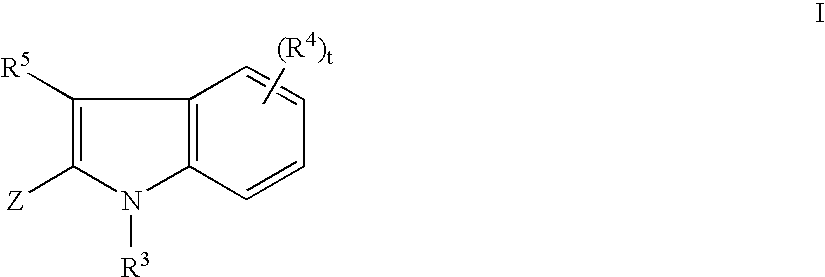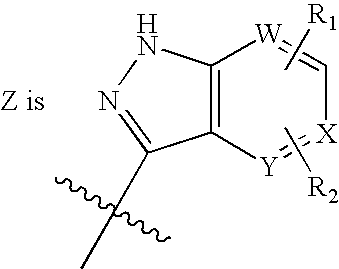Tyrosine kinase inhibitors
a kinase inhibitor and tyrosine technology, applied in the direction of biocide, drug composition, cardiovascular disorder, etc., can solve the problems of visual degeneration, tumor growth is susceptible to antiangiogenic effects, etc., and achieve the effect of inhibiting, modulating and/or regulating signal transduction
- Summary
- Abstract
- Description
- Claims
- Application Information
AI Technical Summary
Benefits of technology
Problems solved by technology
Method used
Image
Examples
second embodiment
the invention is a compound of Formula I, or a pharmaceutically acceptable salt or stereoisomer thereof, wherein
A further embodiment of the present invention is illustrated by a compound of Formula I, or a pharmaceutically acceptable salt or stereoisomer thereof, with Z as defined immediately above, wherein a is 0 or 1; b is 0 or 1;and t is 1 or 2; R1, R2 and R5 are independently selected from: 1) H, 2) (C═O)aObC1-C6 alkyl, 3) (C═O)aObaryl, 4) (C═O)aObC2-C6 alkenyl, 5) (C═O)aObC2-C6 alkynyl, 6) CO2H, 7) halo, 8) OH, 9) ObC1-C3 perfluoroalkyl, 10) (C═O)aNR7R8, 11)CN, 12) (C═O)aObC3-C6 cycloalkyl, 13) (C═O)aObheterocyclyl, 14) SO2NR7R8, and 15) SO2C1-C6 alkyl,
said alkyl, aryl, alkenyl, alkynyl, cycloalkyl, and heterocyclyl is optionally substituted with one or more substituents selected from R6; R4 is selected from: 1) (C═O)aObC1-C6 alkyl, 2) (C═O)aObaryl, 3) (C═O)aObC2-C6 alkenyl, 4) (C═O)aObC2-C6 alkynyl, 5) CO2H, 6) halo, 7) OH, 8) ObC1-C3 perfluoroal...
example 1
Step 1: 6-chloroindazole (1-3b)
A slurry of 5-chloro-2-methylaniline (1-1, 30 g, 0.21 mol) in water (200 mL) was treated with HCl (12N, 53 mL, 0.64 mol). The resulting solution was cooled to 0° C. and reacted with aqueous solution of sodium nitrite (14.6 g, 0.21 mol). After 30 min. stirring, any insoluble particles were removed by filtration and the filtrate solution was treated at 0° C. with sodium tetrafluoroborate dissolved in water (150 mL). Precipitates so formed was collected by filtration, washed with ice-cold water, cold methanol and then with ethylether. The product (1-2) was dried in vacuo and then suspended in chloroform (500 mL) in the presence of potassium acetate (34 g, 0.35 mol) and 18-crown-6 (2.29 g, 8.67 mmol). The reaction mixture was stirred at the ambient temperature for 1.5 h, partitioned between ethyl acetate and water. The organic layer was washed with brine, separated, dried (MgSO4) and concentrated in vacuo. Trituation with dichloromethane and hexanes aff...
example 2
Step 1: 1-(Trifluoroacetyl)indoline (2-1)
To a solution of indoline (30 g, 251.74 mmol) and triethylamine (70.18 mL, 503.48 mmol) in methylene chloride (500 mL) cooled to 0° C. was added trifluoroacetic anhydride (53.34 mL, 377.61 mmol) dropwise over 20 minutes. The reaction mixture was warmed to room temperature and stirred for 30 minutes. The solution was washed once with saturated aqueous NaHCO3 (500 mL), dried over Na2SO4, then concentrated in vacuo. The resulting solid was suspended in hexanes and collected by filtration. The solid was vacuum dried to afford 1-(trifluoroacetyl)indoline; 1H NMR (500 MHz, CDCl3) δ 8.22 (d, 1 H, J=8.54 Hz), 7.27 (m, 2 H), 7.16 (t, 1 H, J=7.5 Hz), 4.28 (t, 2 H, J=8.3 Hz), 3.27 (t, 2 H, J=7.3 Hz).
Step 2: 1-(Trifluoroacetyl)indoline-5-sulfonyl Chloride (2-2)
A solution of the 1-(trifluoroacetyl)indoline (2-1, 21.5 g), neat in thionyl chloride (65.59 mL, 899.24 mmol), was cooled to 0° C. and treated with chlorosulfonic acid (13.28 mL, 199.83 mmol...
PUM
 Login to View More
Login to View More Abstract
Description
Claims
Application Information
 Login to View More
Login to View More - R&D
- Intellectual Property
- Life Sciences
- Materials
- Tech Scout
- Unparalleled Data Quality
- Higher Quality Content
- 60% Fewer Hallucinations
Browse by: Latest US Patents, China's latest patents, Technical Efficacy Thesaurus, Application Domain, Technology Topic, Popular Technical Reports.
© 2025 PatSnap. All rights reserved.Legal|Privacy policy|Modern Slavery Act Transparency Statement|Sitemap|About US| Contact US: help@patsnap.com



